Prashant Pandey
A Language-Guided Benchmark for Weakly Supervised Open Vocabulary Semantic Segmentation
Feb 27, 2023Abstract:Increasing attention is being diverted to data-efficient problem settings like Open Vocabulary Semantic Segmentation (OVSS) which deals with segmenting an arbitrary object that may or may not be seen during training. The closest standard problems related to OVSS are Zero-Shot and Few-Shot Segmentation (ZSS, FSS) and their Cross-dataset variants where zero to few annotations are needed to segment novel classes. The existing FSS and ZSS methods utilize fully supervised pixel-labelled seen classes to segment unseen classes. Pixel-level labels are hard to obtain, and using weak supervision in the form of inexpensive image-level labels is often more practical. To this end, we propose a novel unified weakly supervised OVSS pipeline that can perform ZSS, FSS and Cross-dataset segmentation on novel classes without using pixel-level labels for either the base (seen) or the novel (unseen) classes in an inductive setting. We propose Weakly-Supervised Language-Guided Segmentation Network (WLSegNet), a novel language-guided segmentation pipeline that i) learns generalizable context vectors with batch aggregates (mean) to map class prompts to image features using frozen CLIP (a vision-language model) and ii) decouples weak ZSS/FSS into weak semantic segmentation and Zero-Shot segmentation. The learned context vectors avoid overfitting on seen classes during training and transfer better to novel classes during testing. WLSegNet avoids fine-tuning and the use of external datasets during training. The proposed pipeline beats existing methods for weak generalized Zero-Shot and weak Few-Shot semantic segmentation by 39 and 3 mIOU points respectively on PASCAL VOC and weak Few-Shot semantic segmentation by 5 mIOU points on MS COCO. On a harder setting of 2-way 1-shot weak FSS, WLSegNet beats the baselines by 13 and 22 mIOU points on PASCAL VOC and MS COCO, respectively.
Adversarially Robust Prototypical Few-shot Segmentation with Neural-ODEs
Oct 07, 2022Abstract:Few-shot Learning (FSL) methods are being adopted in settings where data is not abundantly available. This is especially seen in medical domains where the annotations are expensive to obtain. Deep Neural Networks have been shown to be vulnerable to adversarial attacks. This is even more severe in the case of FSL due to the lack of a large number of training examples. In this paper, we provide a framework to make few-shot segmentation models adversarially robust in the medical domain where such attacks can severely impact the decisions made by clinicians who use them. We propose a novel robust few-shot segmentation framework, Prototypical Neural Ordinary Differential Equation (PNODE), that provides defense against gradient-based adversarial attacks. We show that our framework is more robust compared to traditional adversarial defense mechanisms such as adversarial training. Adversarial training involves increased training time and shows robustness to limited types of attacks depending on the type of adversarial examples seen during training. Our proposed framework generalises well to common adversarial attacks like FGSM, PGD and SMIA while having the model parameters comparable to the existing few-shot segmentation models. We show the effectiveness of our proposed approach on three publicly available multi-organ segmentation datasets in both in-domain and cross-domain settings by attacking the support and query sets without the need for ad-hoc adversarial training.
Robust Prototypical Few-Shot Organ Segmentation with Regularized Neural-ODEs
Aug 26, 2022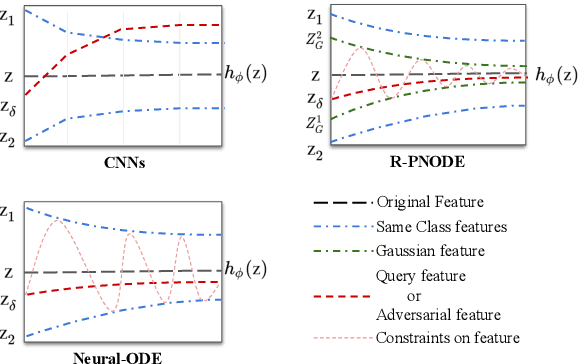
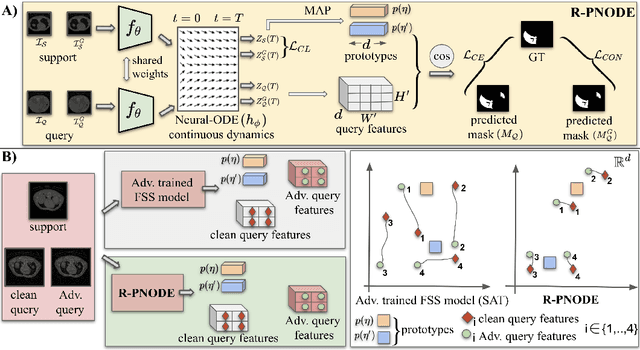


Abstract:Despite the tremendous progress made by deep learning models in image semantic segmentation, they typically require large annotated examples, and increasing attention is being diverted to problem settings like Few-Shot Learning (FSL) where only a small amount of annotation is needed for generalisation to novel classes. This is especially seen in medical domains where dense pixel-level annotations are expensive to obtain. In this paper, we propose Regularized Prototypical Neural Ordinary Differential Equation (R-PNODE), a method that leverages intrinsic properties of Neural-ODEs, assisted and enhanced by additional cluster and consistency losses to perform Few-Shot Segmentation (FSS) of organs. R-PNODE constrains support and query features from the same classes to lie closer in the representation space thereby improving the performance over the existing Convolutional Neural Network (CNN) based FSS methods. We further demonstrate that while many existing Deep CNN based methods tend to be extremely vulnerable to adversarial attacks, R-PNODE exhibits increased adversarial robustness for a wide array of these attacks. We experiment with three publicly available multi-organ segmentation datasets in both in-domain and cross-domain FSS settings to demonstrate the efficacy of our method. In addition, we perform experiments with seven commonly used adversarial attacks in various settings to demonstrate R-PNODE's robustness. R-PNODE outperforms the baselines for FSS by significant margins and also shows superior performance for a wide array of attacks varying in intensity and design.
Contrastive Semi-Supervised Learning for 2D Medical Image Segmentation
Jul 10, 2021



Abstract:Contrastive Learning (CL) is a recent representation learning approach, which encourages inter-class separability and intra-class compactness in learned image representations. Since medical images often contain multiple semantic classes in an image, using CL to learn representations of local features (as opposed to global) is important. In this work, we present a novel semi-supervised 2D medical segmentation solution that applies CL on image patches, instead of full images. These patches are meaningfully constructed using the semantic information of different classes obtained via pseudo labeling. We also propose a novel consistency regularization (CR) scheme, which works in synergy with CL. It addresses the problem of confirmation bias, and encourages better clustering in the feature space. We evaluate our method on four public medical segmentation datasets and a novel histopathology dataset that we introduce. Our method obtains consistent improvements over state-of-the-art semi-supervised segmentation approaches for all datasets.
Domain Generalization via Inference-time Label-Preserving Target Projections
Mar 01, 2021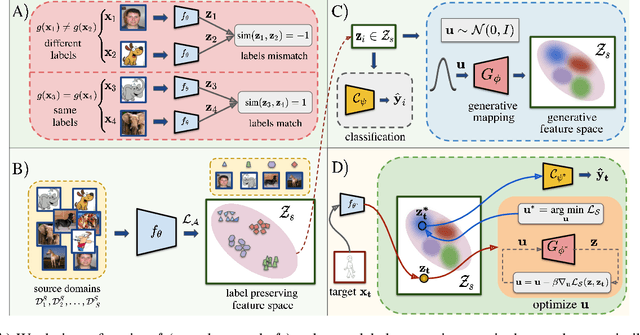
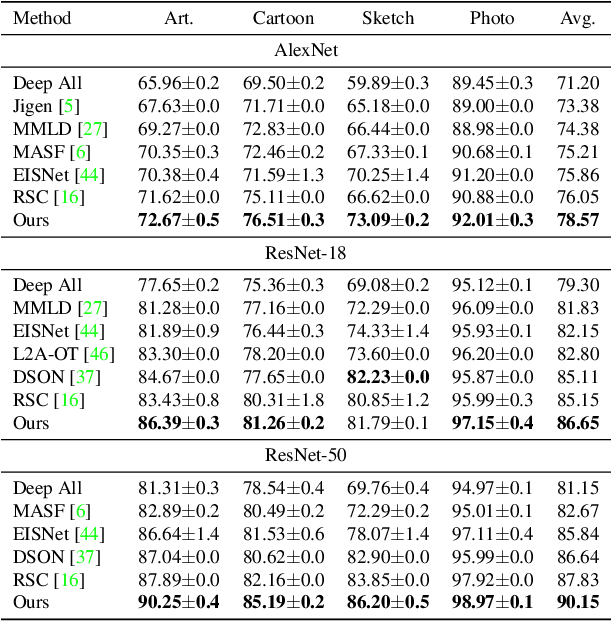
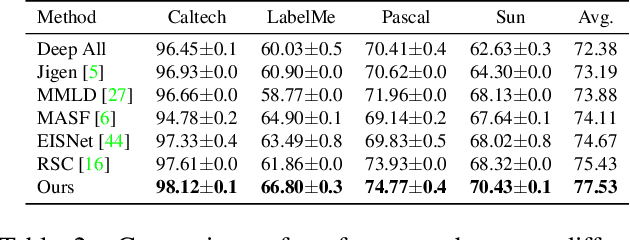

Abstract:Generalization of machine learning models trained on a set of source domains on unseen target domains with different statistics, is a challenging problem. While many approaches have been proposed to solve this problem, they only utilize source data during training but do not take advantage of the fact that a single target example is available at the time of inference. Motivated by this, we propose a method that effectively uses the target sample during inference beyond mere classification. Our method has three components - (i) A label-preserving feature or metric transformation on source data such that the source samples are clustered in accordance with their class irrespective of their domain (ii) A generative model trained on the these features (iii) A label-preserving projection of the target point on the source-feature manifold during inference via solving an optimization problem on the input space of the generative model using the learned metric. Finally, the projected target is used in the classifier. Since the projected target feature comes from the source manifold and has the same label as the real target by design, the classifier is expected to perform better on it than the true target. We demonstrate that our method outperforms the state-of-the-art Domain Generalization methods on multiple datasets and tasks.
Discrepancy Minimization in Domain Generalization with Generative Nearest Neighbors
Jul 28, 2020


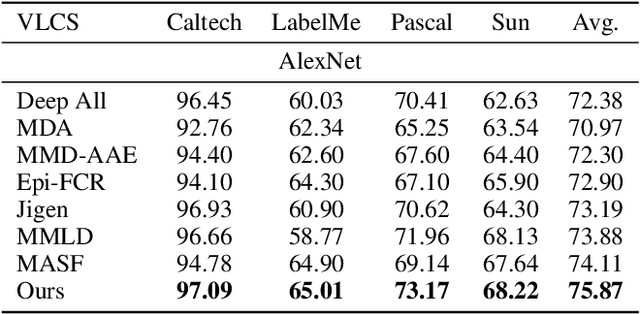
Abstract:Domain generalization (DG) deals with the problem of domain shift where a machine learning model trained on multiple-source domains fail to generalize well on a target domain with different statistics. Multiple approaches have been proposed to solve the problem of domain generalization by learning domain invariant representations across the source domains that fail to guarantee generalization on the shifted target domain. We propose a Generative Nearest Neighbor based Discrepancy Minimization (GNNDM) method which provides a theoretical guarantee that is upper bounded by the error in the labeling process of the target. We employ a Domain Discrepancy Minimization Network (DDMN) that learns domain agnostic features to produce a single source domain while preserving the class labels of the data points. Features extracted from this source domain are learned using a generative model whose latent space is used as a sampler to retrieve the nearest neighbors for the target data points. The proposed method does not require access to the domain labels (a more realistic scenario) as opposed to the existing approaches. Empirically, we show the efficacy of our method on two datasets: PACS and VLCS. Through extensive experimentation, we demonstrate the effectiveness of the proposed method that outperforms several state-of-the-art DG methods.
Unsupervised Domain Adaptation for Semantic Segmentation of NIR Images through Generative Latent Search
Jul 17, 2020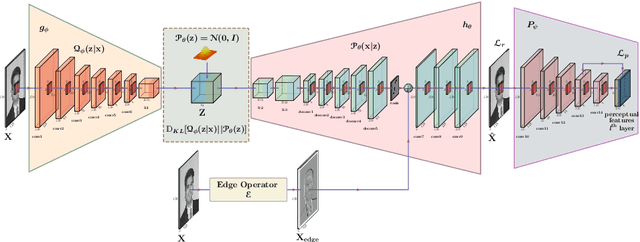

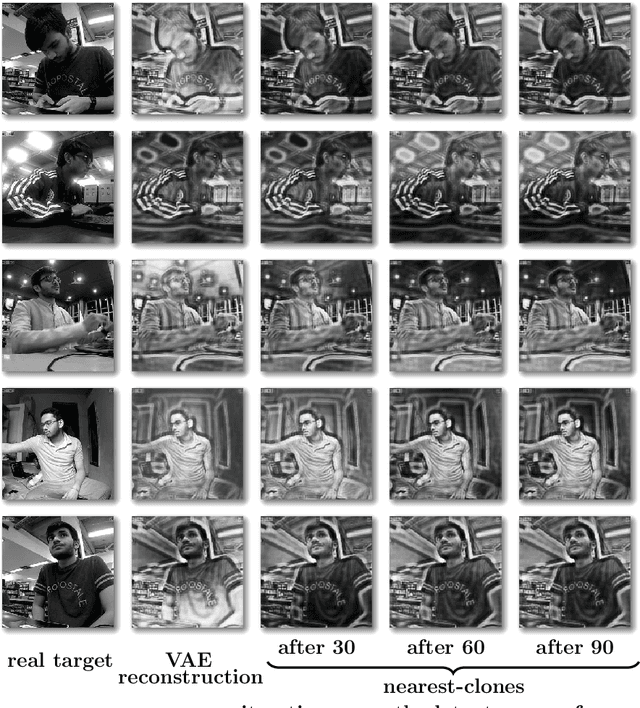
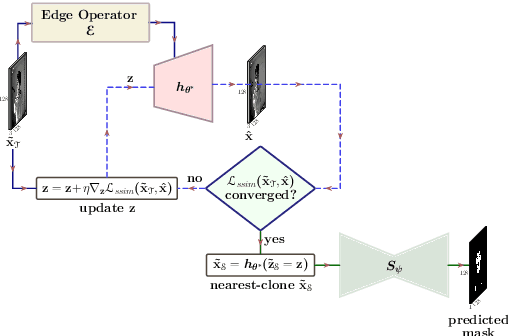
Abstract:Segmentation of the pixels corresponding to human skin is an essential first step in multiple applications ranging from surveillance to heart-rate estimation from remote-photoplethysmography. However, the existing literature considers the problem only in the visible-range of the EM-spectrum which limits their utility in low or no light settings where the criticality of the application is higher. To alleviate this problem, we consider the problem of skin segmentation from the Near-infrared images. However, Deep learning based state-of-the-art segmentation techniques demands large amounts of labelled data that is unavailable for the current problem. Therefore we cast the skin segmentation problem as that of target-independent Unsupervised Domain Adaptation (UDA) where we use the data from the Red-channel of the visible-range to develop skin segmentation algorithm on NIR images. We propose a method for target-independent segmentation where the 'nearest-clone' of a target image in the source domain is searched and used as a proxy in the segmentation network trained only on the source domain. We prove the existence of 'nearest-clone' and propose a method to find it through an optimization algorithm over the latent space of a Deep generative model based on variational inference. We demonstrate the efficacy of the proposed method for NIR skin segmentation over the state-of-the-art UDA segmentation methods on the two newly created skin segmentation datasets in NIR domain despite not having access to the target NIR data. Additionally, we report state-of-the-art results for adaption from Synthia to Cityscapes which is a popular setting in Unsupervised Domain Adaptation for semantic segmentation. The code and datasets are available at https://github.com/ambekarsameer96/GLSS.
Target-Independent Domain Adaptation for WBC Classification using Generative Latent Search
May 11, 2020



Abstract:Automating the classification of camera-obtained microscopic images of White Blood Cells (WBCs) and related cell subtypes has assumed importance since it aids the laborious manual process of review and diagnosis. Several State-Of-The-Art (SOTA) methods developed using Deep Convolutional Neural Networks suffer from the problem of domain shift - severe performance degradation when they are tested on data (target) obtained in a setting different from that of the training (source). The change in the target data might be caused by factors such as differences in camera/microscope types, lenses, lighting-conditions etc. This problem can potentially be solved using Unsupervised Domain Adaptation (UDA) techniques albeit standard algorithms presuppose the existence of a sufficient amount of unlabelled target data which is not always the case with medical images. In this paper, we propose a method for UDA that is devoid of the need for target data. Given a test image from the target data, we obtain its 'closest-clone' from the source data that is used as a proxy in the classifier. We prove the existence of such a clone given that infinite number of data points can be sampled from the source distribution. We propose a method in which a latent-variable generative model based on variational inference is used to simultaneously sample and find the 'closest-clone' from the source distribution through an optimization procedure in the latent space. We demonstrate the efficacy of the proposed method over several SOTA UDA methods for WBC classification on datasets captured using different imaging modalities under multiple settings.
Guided Weak Supervision for Action Recognition with Scarce Data to Assess Skills of Children with Autism
Dec 02, 2019



Abstract:Diagnostic and intervention methodologies for skill assessment of autism typically requires a clinician repetitively initiating several stimuli and recording the child's response. In this paper, we propose to automate the response measurement through video recording of the scene following the use of Deep Neural models for human action recognition from videos. However, supervised learning of neural networks demand large amounts of annotated data that are hard to come by. This issue is addressed by leveraging the `similarities' between the action categories in publicly available large-scale video action (source) datasets and the dataset of interest. A technique called guided weak supervision is proposed, where every class in the target data is matched to a class in the source data using the principle of posterior likelihood maximization. Subsequently, classifier on the target data is re-trained by augmenting samples from the matched source classes, along with a new loss encouraging inter-class separability. The proposed method is evaluated on two skill assessment autism datasets, SSBD and a real world Autism dataset comprising 37 children of different ages and ethnicity who are diagnosed with autism. Our proposed method is found to improve the performance of the state-of-the-art multi-class human action recognition models in-spite of supervision with scarce data.
NEMGAN: Noise Engineered Mode-matching GAN
Nov 08, 2018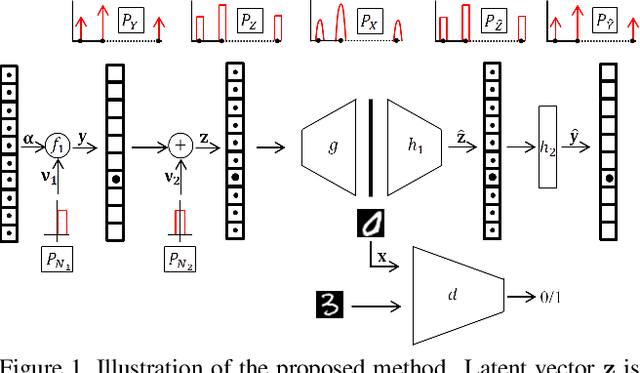
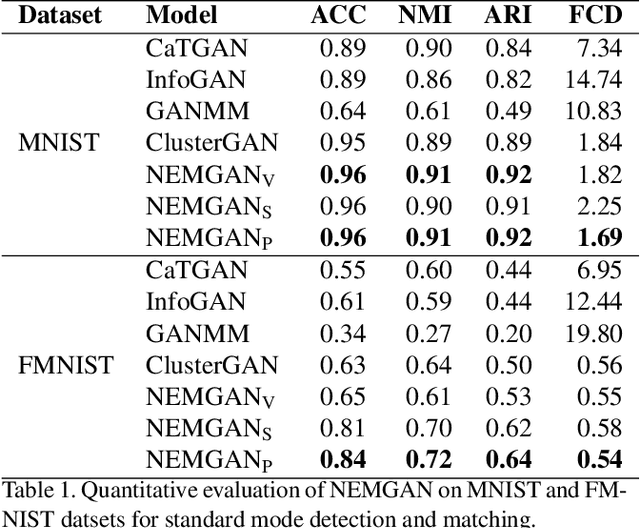

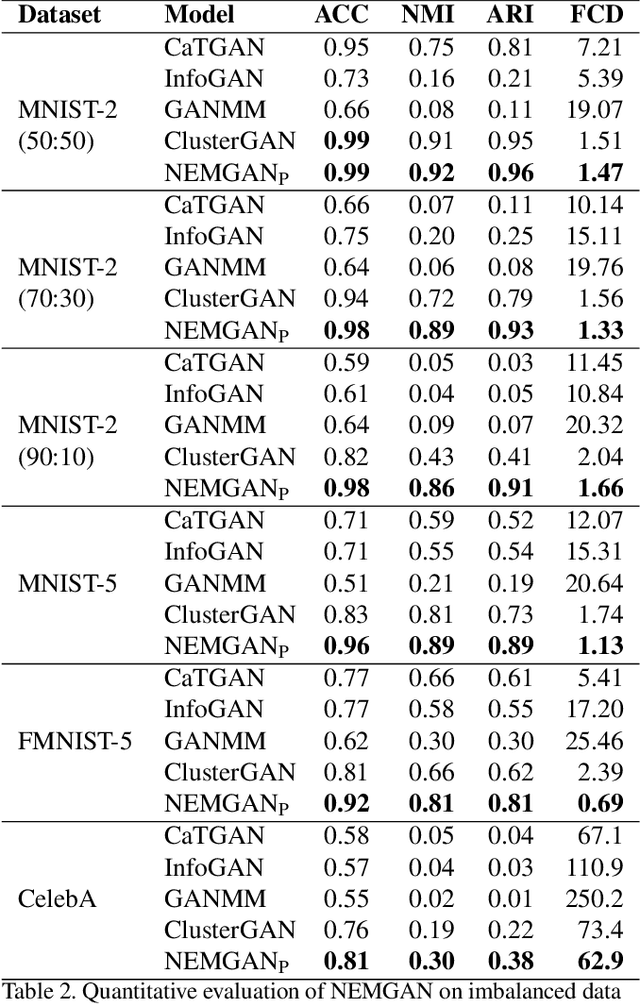
Abstract:Conditional generation refers to the process of sampling from an unknown distribution conditioned on semantics of the data. This can be achieved by augmenting the generative model with the desired semantic labels, albeit it is not straightforward in an unsupervised setting where the semantic label of every data sample is unknown. In this paper, we address this issue by proposing a method that can generate samples conditioned on the properties of a latent distribution engineered in accordance with a certain data prior. In particular, a latent space inversion network is trained in tandem with a generative adversarial network such that the modal properties of the latent space distribution are induced in the data generating distribution. We demonstrate that our model despite being fully unsupervised, is effective in learning meaningful representations through its mode matching property. We validate our method on multiple unsupervised tasks such as conditional generation, attribute discovery and inference using three real world image datasets namely MNIST, CIFAR-10 and CelebA and show that the results are comparable to the state-of-the-art methods.
 Add to Chrome
Add to Chrome Add to Firefox
Add to Firefox Add to Edge
Add to Edge